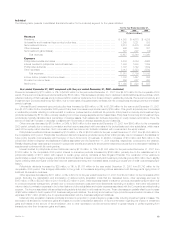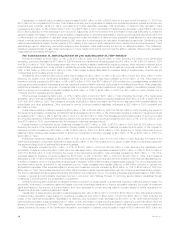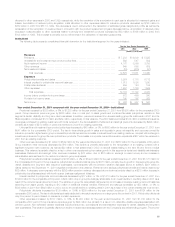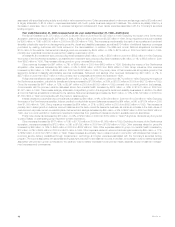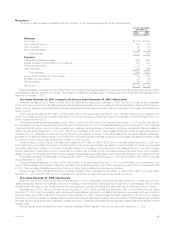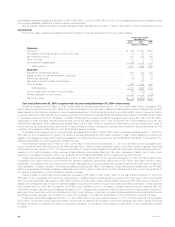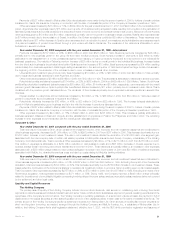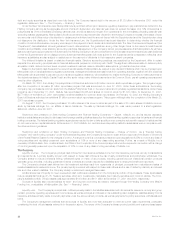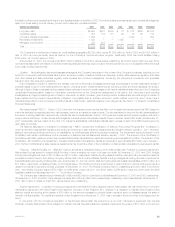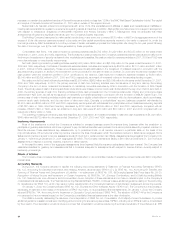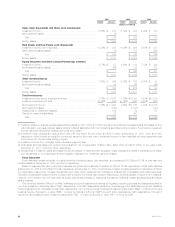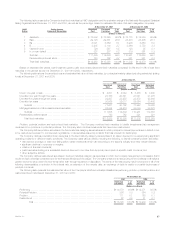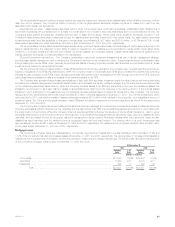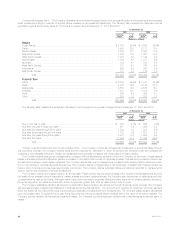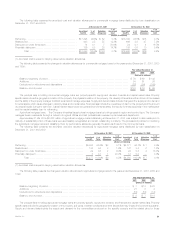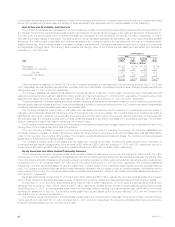MetLife 2001 Annual Report Download - page 26
Download and view the complete annual report
Please find page 26 of the 2001 MetLife annual report below. You can navigate through the pages in the report by either clicking on the pages listed below, or by using the keyword search tool below to find specific information within the annual report.
the likelihood that normal operations will result in any significant strain on liquidity in 2002. The following table summarizes its major contractual obligations,
apart from those arising from its ordinary product and investment purchase activities:
Contractual Obligations Total 2002 2003 2004 2005 2006 Thereafter
Long-term debt ******************************************* $3,628 $207 $439 $ 27 $ 272 $609 $2,074
Operating leases ****************************************** 607 132 113 92 76 60 134
Company-obligated securities ******************************* 1,356 — — — 1,006 — 350
Partnership investments ************************************ 1,898 — — 1,898 — — —
Mortgage commitments ************************************ 423 423 — — — — —
Total **************************************************** $7,912 $762 $552 $2,017 $1,354 $669 $2,558
The Company’s committed and unsecured credit facilities aggregating $2,250 million expire $1,250 million in April of 2002 and $1,000 million in
April of 2003 and are principally used as backup for the Company’s commercial paper program. Additionally, RGA has credit facilities totaling
$180 million, all of which expire in 2005.
At December 31, 2001, the Company had $473 million in letters of credit from various banks outstanding, all of which expire within one year. Since
commitments associated with letters of credit and financing arrangements may expire unused, the amounts shown do not necessarily reflect the actual
future cash funding requirements.
Litigation. Various litigation claims and assessments against the Company have arisen in the course of the Company’s business, including, but not
limited to, in connection with its activities as an insurer, employer, investor, investment advisor and taxpayer. Further, state insurance regulatory authorities
and other federal and state authorities regularly make inquiries and conduct investigations concerning the Company’s compliance with applicable
insurance and other laws and regulations.
It is not feasible to predict or determine the ultimate outcome of all pending investigations and legal proceedings or provide reasonable ranges of
potential losses. In some of the matters referred to above, very large and/or indeterminate amounts, including punitive and treble damages, are sought.
Although in light of these considerations it is possible that an adverse outcome in certain cases could have a material adverse effect upon the Company’s
consolidated financial position, based on information currently known by the Company’s management, in its opinion, the outcomes of such pending
investigations and legal proceedings are not likely to have such an effect. However, given the large and/or indeterminate amounts sought in certain of
these matters and the inherent unpredictability of litigation, it is possible that an adverse outcome in certain matters could, from time to time, have a
material adverse effect on the Company’s operating results or cash flows in particular quarterly or annual periods. See Note 11 of Notes to Consolidated
Financial Statements.
Risk-based capital (‘‘RBC’’). Section 1322 of the New York Insurance Law requires that New York domestic life insurers report their RBC based on
a formula calculated by applying factors to various asset, premium and statutory reserve items. The formula takes into account the risk characteristics of
the insurer, including asset risk, insurance risk, interest rate risk and business risk. Section 1322 gives the Superintendent explicit regulatory authority to
require various actions by, or take various actions against, insurers whose total adjusted capital does not exceed certain RBC levels. At December 31,
2001, Metropolitan Life’s and each of the other U.S. insurance subsidiaries’ total adjusted capital was in excess of each of the RBC levels required by
each state of domicile.
The National Association of Insurance Commissioners’ (‘‘NAIC’’) adopted the Codification of Statutory Accounting Principles (the ‘‘Codification’’),
which is intended to standardize regulatory accounting and reporting to state insurance departments and became effective January 1, 2001. However,
statutory accounting principles continue to be established by individual state laws and permitted practices. The Department required adoption of the
Codification with certain modifications, for the preparation of statutory financial statements effective January 1, 2001. The adoption of the Codification in
accordance with NAIC guidance would have increased Metropolitan Life’s statutory capital and surplus by approximately $1.5 billion. The adoption of the
Codification, as modified by the Department, increased Metropolitan Life’s statutory capital and surplus by approximately $84 million, as of January 1,
2001. Further modifications by state insurance departments may impact the effect of the Codification on Metropolitan Life’s statutory surplus and capital.
Financing. MetLife Funding, Inc. (‘‘MetLife Funding’’) serves as a centralized finance unit for Metropolitan Life. Pursuant to a support agreement,
Metropolitan Life has agreed to cause MetLife Funding to have a tangible net worth of at least one dollar. At December 31, 2001 and 2000, MetLife
Funding had a tangible net worth of $10.6 million and $10.3 million, respectively. MetLife Funding raises funds from various funding sources and uses the
proceeds to extend loans to the Holding Company, Metropolitan Life and other affiliates. MetLife Funding manages its funding sources to enhance the
financial flexibility and liquidity of Metropolitan Life. At December 31, 2001 and 2000, MetLife Funding had total outstanding liabilities of $133 million and
$1.1 billion, respectively, consisting primarily of commercial paper. The Holding Company is authorized to raise funds from various funding sources and
uses the proceeds for general corporate purposes. At December 31, 2001, the Holding Company had no outstanding short-term debt. In November
2001, the Holding Company issued $750 million 6.125% senior notes due 2011 and $500 million 5.25% senior notes due 2006 under the shelf
registration statement discussed above in ‘‘— The Holding Company.’’
The Company also maintained approximately $2.4 billion and $2 billion in committed credit facilities at December 31, 2001 and 2000, respectively.
At December 31, 2001 and 2000, there was approximately $24 million and $98 million, respectively, outstanding under these facilities. At December 31,
2001, $473 million in letters of credit from various banks were outstanding.
Support agreements. In addition to its support agreement with MetLife Funding described above, Metropolitan Life has entered into a net worth
maintenance agreement with New England Life Insurance Company (‘‘New England Life’’), whereby it is obligated to maintain New England Life’s
statutory capital and surplus at the greater of $10 million or the amount necessary to prevent certain regulatory action by Massachusetts, the state of
domicile of this subsidiary. The capital and surplus of New England Life at December 31, 2001 was in excess of the amount that would trigger such an
event.
In connection with the Company’s acquisition of GenAmerica, Metropolitan Life entered into a net worth maintenance agreement with General
American, whereby Metropolitan Life is obligated to maintain General American’s statutory capital and surplus at the greater of $10 million or the amount
MetLife, Inc. 23


